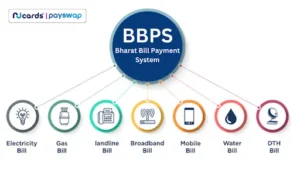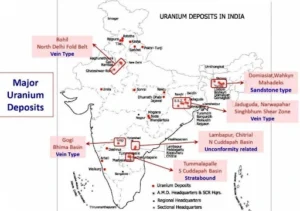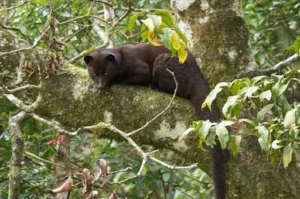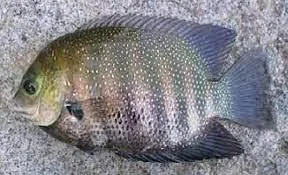UPSC GS 1
Gandaki River
- News: A 15-year-old bridge over the Gandaki River collapsed in Bihar’s Saran district.
- Alternative Names: Also known as the Narayani and Gandak, it is one of the major rivers in Nepal and a left-bank tributary of the Ganges in India.
- Origin: Formed by the union of the Kali and Trisuli rivers, which rise in the Great Himalaya Range in Nepal.
- Flow Path:
-
- From the junction of Kali and Trisuli rivers to the Indian border, it is called the Narayani.
- It flows southwest into India, then turns southeast along the Uttar Pradesh–Bihar state border, and across the Indo-Gangetic Plain.
- It enters the Ganges River opposite Patna, Bihar, after a winding course of 475 miles (765 km).
-
- Catchment Area:
-
- Bounded by the Himalayas to the north, the River Ganga to the south, the Burhi Gandak Basin to the east, and the Ghagra Basin to the west.
- Glaciers and Lakes: The upper catchment of the Gandaki has about 1,710 glaciers and over 300 lakes.
-
- Deep Gorge: Known for possessing a deep gorge in the Himalayan region, with the deepest point reaching approximately 3,000 meters (9,800 feet), making it one of the deepest river gorges in the world.
- Tributaries: Daraudi, Seti, Madi, Marsyandi, and Budhi Gandaki.
- Historical Mention: The Gandaki River is mentioned in the ancient Sanskrit epic Mahabharata.
Read also: UPSC Current Affairs: Shree Jagannath Temple, Gallantry Awards, Mount Etna, Pangong Lake, and More
UPSC GS 2
Bharat Bill Payment System (BBPS)
- News: The Reserve Bank of India (RBI) has mandated that all credit card payments be routed through the Bharat Bill Pay System from July 1, 2024.
- Concept and Management:
-
- It is a payment channel system conceptualized by the Reserve Bank of India (RBI) and driven by the National Payments Corporation of India (NPCI).
- NPCI is a subsidiary of the RBI.
-
- Aim:
-
- It serves as a one-stop payment platform for all bills, providing interoperable and accessible “Anytime Anywhere” bill payment service to customers across India.
- The RBI aims to regulate and monitor P2P credit card transactions through third-party apps.
- Unlike regular transactions settled directly with banks, these payments use NEFT/IMPS or direct transfers, bypassing centralized platforms, which concerns the RBI.
-

- Features and Benefits:
-
- Transaction Certainty: BBPS ensures the certainty, reliability, and safety of transactions.
- Payment Modes: The system supports multiple payment modes and provides instant confirmation of receipt of payment.
- Integrated Platform: BBPS is an integrated platform connecting banks and non-banks involved in the bills aggregation business, including billers, payment service providers, and retail bill outlets.
- Convenience: It catalogs various utility providers on one platform, offering customers the convenience of paying multiple bills through a single window.
-
- Bill Collection Categories:
-
- Utilities: Includes electricity, telecom, mobile postpaid, DTH, gas, and water bills.
- Other Payments: Will include school/university fees, municipal taxes/payments, mutual funds, insurance premiums, various government taxes, etc., as decided by the RBI over time.
-
- Payment Channels:
-
- Physical Outlets: Customers can make payments at physical payment collection outlets such as bank branches and agent collection stores.
- Digital Channels: Payments can also be made through digital channels like apps and websites across India.
- Instant Confirmation: BBPS provides instant confirmation of payment via an SMS or receipt.
-
UPSC GS 3
Uranium
- News: Russia and India are likely to agree on a long-term uranium supply pact for a nuclear power plant coming online in the southern state of Tamil Nadu.
- Definition:
-
- Uranium is a naturally occurring radioactive element with an atomic number of 92.
- It decays over time, releasing energy.
-
- Properties:
-
- Uranium is a relatively common metal, found in rocks and seawater.
- Uranium ranks 48th among the most abundant elements in natural crustal rock.
- Uranium is 18.7 times denser than water.
- The U-235 isotope of Uranium is important due to its fissile nature, allowing it to be split under certain conditions, releasing a lot of energy (nuclear fission).
- U-238 is the most common isotope, accounting for around 99% of natural uranium.
- U-238 decays very slowly and is barely radioactive.
-

- Uranium Enrichment:
-
- Uranium enrichment is the process of increasing the isotopic proportion of U-235 from 0.72% to up to 94%.
-
- Global Production:
-
- Leading Producers: Kazakhstan, Canada, and Australia.
-
- Important Mines:
-
- Australia: Olympic Dam and the Ranger mine in Southern Australia.
- Canada: High-grade deposits are found in the Athabasca Basin region. Important sites include Cigar Lake and McArthur River basin.
- Kazakhstan: The Chu-Sarysu basin in central Kazakhstan accounts for over half of the country’s known uranium resources.
-
- Uranium in India:
-
- The first uranium deposit in India was found in 1951 at Jaduguda, in the Singhbhum Thrust Belt (Jharkhand).
- Andhra Pradesh is the largest producer of uranium in India.
- Other major uranium deposits: Cuddapah basin (Andhra Pradesh and Telangana), Mahadek basin (Meghalaya), Delhi Supergroup of rocks (Rajasthan), and Bhima basin (Karnataka).
-
Regenerative Braking
- News: Electric vehicles, boosted by state incentives and subsidies, are advancing rapidly. A key feature is regenerative braking, which enhances energy efficiency.
- What is Braking?
-
- Braking is the mechanism by which an automotive vehicle in motion slows down.
- It removes kinetic energy from the vehicle.
-
- Kinetic Energy:
-
- Kinetic energy is the energy an object has because of its motion.
- A vehicle moving faster has more kinetic energy than one moving slower.
- The process of braking converts kinetic energy to another form due to the law of energy conservation.
- Examples :
- A disc brake is a type of mechanical brake that presses brake pads against a spinning disc, using friction to convert kinetic energy into heat. The discs have holes to dissipate heat more effectively.
- An induction brake uses a magnet to induce circular electric currents in a spinning metal wheel, creating a magnetic field that opposes the external magnet. This opposition slows the wheel and dissipates energy as heat.
-
- What is Regenerative Braking?
-
- Definition: Regenerative braking converts the wheels’ kinetic energy into a storable form, allowing the energy to be recovered and used later when the vehicle doesn’t need it.
- Dynamic Braking: Regenerative braking is a type of dynamic braking.
- Electric Vehicle Process:
- In electric vehicles, a battery stores electric power from the grid.
- This battery powers a traction motor, converting electrical energy to mechanical energy to propel the vehicle.
- During braking, the motor operates as a generator, turning mechanical energy back to electrical energy.
- The electric current produced during braking is stored in a battery or, in some vehicles, fed back into the traction motor.
-
- Rheostatic Braking: Another type of dynamic braking where the current is sent to resistors that dissipate the electrical energy as heat.
- Problems with Regenerative Braking:
-
- It often can’t stop an electric vehicle alone and must be used with a conventional system that dissipates kinetic energy as heat.
- Conventional system is also required to prevent vehicles from backsliding downhill, which many regenerative brakes won’t prevent.
- The amount of energy a regenerative brake can recover drops as the vehicle’s velocity drops as well.
-
- Advantages of Regenerative Braking:
-
- It improves the fuel economy of the vehicle. The amount of fuel consumed can be dramatically reduced.
- It allows for traditional friction-based brakes. A friction braking system is included with a regenerative system to ensure a vehicle is able to stop in time.
- It prolongs the charge of the battery.
- It reduces the wear and tear on the braking system
-
Carcinogenic Agents In Food
- News: Karnataka has cracked down on sellers of food staples, such as gobi manchurian and pani puri due to use of carcinogenic chemicals in food items.
- Banned Artificial Colouring Agents:
-
- Rhodamine-B, tartrazine dye, and sunset yellow colouring.
-
- Rhodamine B:
-
- It is a chemical colour used in dyeing clothes, paper, leather, printing, and plastics.
- It is used to give red and pink colours.
- Rhodamine B is not one of the permitted food colouring agents under India’s food safety regulation.
-
- Tartrazine:
-
- Tartrazine is a lemon yellow dye.
- It is found in confectionery, cotton candy, soft drinks, instant puddings, flavored chips (Doritos, Nachos), cereals (corn flakes, muesli) etc.
-
- Sunset Yellow Colouring:
-
- It is a synthetic azo dye permitted to be added to a variety of beverages and foods.
- An azo dye comprises two amines joined together through their amino groups by means of an azo bond.
-
- Carmoisine:
-
- It is a synthetic red azo dye, commonly added to food, beverages, medicine, and cosmetics.
-
- Risks:
-
- Rhodamine-B is carcinogenic(causing cancer).
- Rhodamine B may also damage the eye and cause irritation in the respiratory tract.
- Rhodamine B is not fit for consumption and may lead to acute toxicity.
- Tartrazine & Sunset Yellow can cause allergic or pseudo-allergic reaction.
- Carmoisine can cause skin rashes & respiratory allergies.
- Consumption of snacks containing these artificial colours may pose long-term health risks, including cancer.
-
- Punishment on Violation:
-
- Using these harmful chemicals violates the Food Safety and Standards (Food Products, Standards and Food Additives) Regulations, 2011.
- Violation attracts imprisonment of up to 7 years and fine of up to Rs 10 lakhs.
-
- Food Colours Allowed by FSSAI:
-
- The Food Safety and Standards Authority of India (FSSAI), India’s apex food safety regulator, allows the use of very few natural and synthetic colours in food items.
- There is also a restriction on which colours can be used in what type of food product.
- Natural Food Colours: The natural food colours whose use is allowed includes: carotene and carotenoids (yellow, orange), chlorophyll (green), riboflavin (yellow), caramel, Annatto (orange-red, derived from the seed of an American tree), saffron, and circumin (yellow, from turmeric).
- Synthetic Colours: The synthetic colours allowed include red from Ponceau 4R, Carmoisine, and Erythrosine; yellow from Tartrazine and Sunset Yellow FCF, blue from Indigo Carmine and Brilliant Blue FCF, and green from: Fast Green FCF.
- Permitted Food Items:
- Permissible food colourings are not allowed in all food items.
- Food items that can use these colours include ice creams, biscuits, cakes, confectionaries, fruit syrups and crushes, custard powder, jelly crystals, and carbonated or noncarbonated beverages.
-
Brown Palm Civet (Paradoxurus Jerdoni)
- News: A rare sighting of the Brown Palm Civet has been reported in Koyna Wildlife Sanctuary.
- Common Names: Also known as Jerdon’s palm civets, they are endemic to the Western Ghats.
- Ecological Role:
-
- Brown Palm Civets play a vital role as seed dispersers in their habitat.
- Their presence is crucial in areas where other large seed dispersers are either non-existent or rare due to human-induced factors, promoting native rainforest growth in the Western Ghats.
-

- Behavior and Habitat:
-
- Solitary and Nocturnal: Brown Palm Civets are solitary and nocturnal small carnivores.
- Habitat: They thrive in high-altitude tropical rainforests.
- Distribution: It is endemic to the Western Ghats.
- Found in Anamalai, Periyar, Parambikulam, Kalakkad Mundanthurai and Meghamalai Tiger Reserves; Kodaikanal, Munnar forest divisions; and Srivilliputhur.
- Also found from Castle Rock in Goa.
- Elevation: Inhabit rainforest tracts at elevations of 500–1,300 meters.
-
- Food Habits:
-
- Diet: Predominantly frugivorous, they forage widely but have one of the smallest diet ranges among South Asia’s small carnivores.
-
- Conservation Status:
-
- IUCN Status: Least Concern
- CITES Listing: Appendix III
- Wildlife (Protection) Act 1972: Schedule II
-
- Koyna Wildlife Sanctuary:
-
- It is situated in the Western Ghats of Maharashtra.
- It is an important protected area within the larger Western Ghats, a UNESCO World Heritage Site.
- Koyna Wildlife Sanctuary area is known as the renewable energy capital of Maharashta because of its hydro electric and wind energy projects.
- It is closely associated with the Koyna Dam, which is one of the largest dams in Maharashtra.
- Flora: Evergreen forests, semi-evergreen forests, and deciduous forests, teak, shisham, and ain, along with a diverse understorey of shrubs and herbs.
- Fauna: Indian bison (gaur), Indian elephants, Indian leopards, sloth bears, sambar deer etc.
-
Pearl Spot Fish (Etroplus suratensis)
- News: The Kerala University of Fisheries and Ocean Studies (Kufos) is preparing to launch a genome editing mission to enhance pearl spot fish production.
- Common Name:
-
- Known as “Karimeen” in Kerala, it is an indigenous fish found along the east and south-west coasts of Peninsular India.
- The Government of Kerala declared pearlspot as the official fish of Kerala.
- It belongs to the family Cichlidae.
-
- Habitat:
-
- Pearlspot is a euryhaline fish, thriving well in brackish waters and has the ability to live both in fresh and saline waters.
- It is also an important candidate species for aquaculture in ponds.
-

- Physical Characteristics:
-
- Elevated, laterally compressed body.
- Small cleft mouth.
- Light green color with eight vertical bands in its natural habitat.
-
- Year-Round Availability: Seed of pearl spot is available throughout the year along the east and south-west coasts of India.
- Peak Seasons: May-July and November-February are the peak seasons of abundance.
- Geographical Range: Widely available in the South, especially in the Kerala backwaters, Karnataka, and Andhra Pradesh.
- Nutrient-Rich: Low-fat, high-protein food, rich in omega-3 fatty acids, which are beneficial for heart and brain health.
-
- Rich in Vitamin D and riboflavin.
- Contains minerals such as calcium and phosphorus.
-
- IUCN Status: Least Concern

